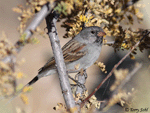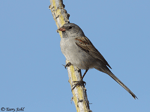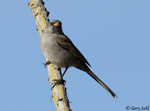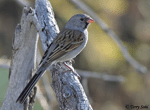| Length: 5.75 inches | Wingspan: 7.75 inches | Seasonality: Non-resident in South Dakota |
| ID Keys: Smooth gray head and underparts, black throat on breeding male, brownish streaked back | ||
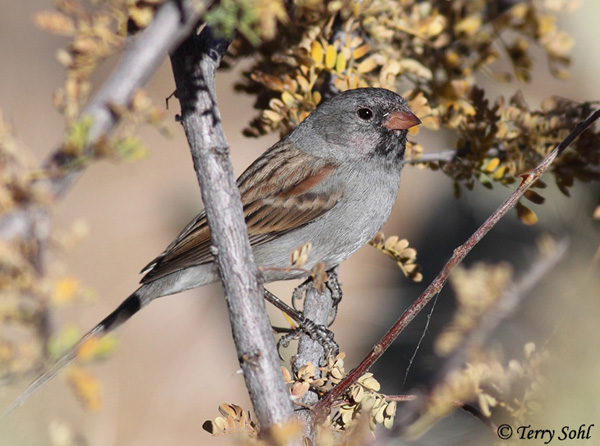 The
Black-chinned Sparrow is found in scattered areas of the southwestern U.S.
and in Mexico, where it is most often found in dense, brushy habitat.
They are named for the black "chin" (throat) that males exhibit during the
breeding season. While locally common in their normal range,
with their preference for dense, brushy areas, often on relatively
inaccessible slopes, there are fewer confirmed details regarding breeding
and feeding characteristics than with most other birds in the region.
The
Black-chinned Sparrow is found in scattered areas of the southwestern U.S.
and in Mexico, where it is most often found in dense, brushy habitat.
They are named for the black "chin" (throat) that males exhibit during the
breeding season. While locally common in their normal range,
with their preference for dense, brushy areas, often on relatively
inaccessible slopes, there are fewer confirmed details regarding breeding
and feeding characteristics than with most other birds in the region.
Habitat: Can be found on a variety of brushy habitats, typically dryland shrubs such as sagebrush, chaparral, or manzanita.
Diet: Feeds on both seeds and insects. Insects likely make up a large part of the diet during the summer months, and young are raised on insects. Seeds may comprise a larger portion of the winter diet, when insects are less available.
Behavior: Most feeding is done by foraging on the ground, although they will also forage low in shrubs and other plants. Gregarious outside of the nesting season, Black-chinned Sparrows will forage in small flocks, oftentimes mixed with other sparrow species.
Nesting: The nest is built very low to the ground, often within a few inches of the ground to 5 feet from the ground. The nest is built in a dense shrub (most often sagebrush), and is made of grasses, herbaceous plant stems, and yucca fibers. Both species incubate the eggs, and both parents help to raise the young.
Interactive eBird Map: Click to access an interactive eBird map of Black-chinned Sparrow sightings
Song: Song of the Black-chinned Sparrow is a series of high-pitched notes with an accelerating pace, ending with a trill.
Migration: Most birds in the United States are migratory. They tend to migrate quite early, in the late summer or early fall, moving to extreme southern Arizona, southern New Mexico, and Mexico. Some birds in the far southern part of their U.S. range may be non-migratory. Most birds in the Mexican part of the range are non-migratory.
Feeders: Will occasionally be found at feeders for seeds.
Similar Species: Fairly distinctive if seen well. Possibly confused with Black-throated Sparrow, Five-striped Sparrow
Conservation Status: There are currently no perceived major threats to Black-chinned Sparrow populations, and the IUCN cites it as a species of "Least Concern".
Further Information: 1) Cornell's Neotropical Birds - Black-chinned Sparrow
2) Audubon - Black-chinned Sparrow
3) WhatBird - Black-chinned Sparrow
Photo Information: December 10th, 2010 - Saguaro National Park, Arizona - Terry Sohl
| Click below for a higher-resolution map |
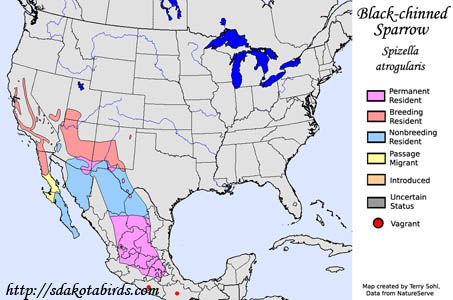 |
| South Dakota Status: Non-resident in South Dakota |
Additional Black-chinned Sparrow Photos
Click for a higher-resolution version of these photos
